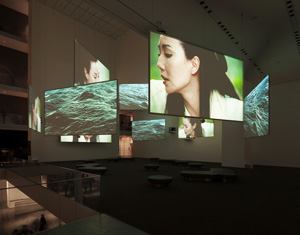9.25.24 — His Finest Hour
“My back is scarred by the lash—that I could show you. I would if I could make visible the wounds of this system upon my soul.”
Frederick Douglass made the wounds of slavery visible for a generation of white Americans, starting before the system itself came to an end in the Civil War. Making visible is also the business of art, and Isaac Julien recreates an address by Douglass in all its eloquence, on “What to the Slave Is the Fourth of July?” And what is it, Julien asks implicitly, to African Americans today? The address provides the framework for an intimate look at the speaker’s life as a free man,  on video at MoMA. In the exhibition’s title, it poses Lessons of the Hour, through September 28. It asks, too, whether a divided nation can ever escape slavery’s lessons.
on video at MoMA. In the exhibition’s title, it poses Lessons of the Hour, through September 28. It asks, too, whether a divided nation can ever escape slavery’s lessons.
This could be Julien’s year. Douglass escaped slavery in at age twenty-one, in 1838, and Lessons of the Hour takes its title from a speech in 1894, a year before his death. Again on video, in the 2024 Whitney Biennial, Julien brings to life the Harlem Renaissance and its leading sculptor. He also curates an exhibition of that sculptor, and I bring together my reviews of that exhibition and Julien’s video as a longer review and my latest upload. As I wrote then, there is nothing savage about the art of Richmond Barthé—and, if there were, he would be the first to tame it. If you have any doubts, head right for Feral Benga, in a gallery retrospective of a thoroughly sophisticated artist.
“I have watched from the wharves,” Douglass said, “the slave ships in the Basin, anchored from the shore, with its cargoes full of human flesh. . . . In the still darkness of midnight, I have been often aroused by the dead heavy footsteps, and the piteous cries of the chained gangs that passed our door.” His words evoke pictures, and so does Isaac Julian, but less painful ones. He opens to trees, to a gentleman’s study and a woman sewing, and to the man himself, slowly leading a horse. He follows Douglass on the train, looking inward and perhaps creating those words in his head. He ends with Douglass standing tall on a mountain’s peak, like the statue of a hero.
He works in film, transferred to video, for the epic clarity of its color. It runs from day into night and from introspection to fireworks on, of course, the Fourth of July. It includes shots of an hourglass marking the hour, if not its lessons. Still, time and history have a way of playing tricks. Day breaks again after the fireworks, on its way to the mountain. The sands of time sometimes flow and sometimes stand still.
Julien hopes to encompass both reality and hope, especially when they collide. A hand picks cotton, but it might almost be picking white flowers for their beauty, with echoes soon after in yellow glistening on a tree. The audience for oratory files into a Methodist church with the bare architecture of an arena today. It includes blacks and whites, men and women—some in the fashion of the day, others in the present. Other clips borrow police surveillance tape of protests against police murder, although I somehow missed them. The video runs just under half an hour, but one can enter as one pleases and, in time, see the loop begin again.
I first encountered the artist, born in England, in London in 2003, already moving in and out of history. Two videos placed him both within a Trinidad community forty years earlier, after a poem by Derek Walcott, and a contemporary city much like Baltimore, where Douglass lived as well. When I caught up with Julien again, with Playtime in 2013, I worried that he fixed all too easily on his heroes and villains. (Do read my review then, for a fuller picture.) Has he finally found the hero he deserves? Has his hero found the response he deserves, in fireworks and, in church, applause?
As Douglass, Ray Fearon makes his character nuanced, steady, personal, and profound (and I wish that the museum took more care to credit him). Then again, I may have sold Julien short all along. Ten Thousand Waves, in 2010, already has many messages and many channels to mess them up. His latest video, a highlight of the Biennial, comes closer still to an installation and a hall of mirrors. It also moves easily in time, back to the Harlem Renaissance. Now MoMA presents Lessons of the Hour, first shown in 2019, as a historical document itself.
Douglass was the most photographed American of his time. And the curators, Ugochukwu-Smooth C. Nzewi with Erica DiBenedetto, set out photos, publications, and newspaper clippings, floor to ceiling and in cases. They also include the handwritten text of a speech on the role of images of black and white America. Is blackness once again “going dark,” feared by or invisible to white eyes? For Julien, Douglass speaks forcefully but never gets over his introspection, his memories, and his pain. “Anything, no matter what, to get rid of thinking!”
Read more, now in a feature-length article on this site.